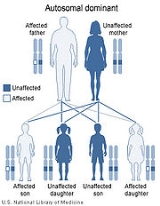
Von Hippel-Lindau disease
Overview
Rare disease
A rare disease, also referred to as an orphan disease, is any disease that affects a small percentage of the population.Most rare diseases are genetic, and thus are present throughout the person's entire life, even if symptoms do not immediately appear...
, autosomal dominant genetic condition in which hemangioblastoma
Hemangioblastoma
Hemangioblastomas are tumors of the central nervous system that originate from the vascular system usually during middle-age. Sometimes these tumors occur in other sites such as the spinal cord and retina...
s are found in the cerebellum
Cerebellum
The cerebellum is a region of the brain that plays an important role in motor control. It may also be involved in some cognitive functions such as attention and language, and in regulating fear and pleasure responses, but its movement-related functions are the most solidly established...
, spinal cord
Spinal cord
The spinal cord is a long, thin, tubular bundle of nervous tissue and support cells that extends from the brain . The brain and spinal cord together make up the central nervous system...
, kidney
Kidney
The kidneys, organs with several functions, serve essential regulatory roles in most animals, including vertebrates and some invertebrates. They are essential in the urinary system and also serve homeostatic functions such as the regulation of electrolytes, maintenance of acid–base balance, and...
and retina
Retina
The vertebrate retina is a light-sensitive tissue lining the inner surface of the eye. The optics of the eye create an image of the visual world on the retina, which serves much the same function as the film in a camera. Light striking the retina initiates a cascade of chemical and electrical...
. These are associated with several pathologies including renal angioma
Angioma
Angiomas are benign tumors derived from cells of the vascular or lymphatic vessel walls or derived from cells of the tissues surrounding these vessels....
, renal cell carcinoma
Renal cell carcinoma
Renal cell carcinoma is a kidney cancer that originates in the lining of the proximal convoluted tubule, the very small tubes in the kidney that filter the blood and remove waste products. RCC is the most common type of kidney cancer in adults, responsible for approximately 80% of cases...
and pheochromocytoma
Pheochromocytoma
A pheochromocytoma or phaeochromocytoma is a neuroendocrine tumor of the medulla of the adrenal glands , or extra-adrenal chromaffin tissue that failed to involute after birth and secretes excessive amounts of catecholamines, usually noradrenaline , and adrenaline to a lesser extent...
. VHL results from a mutation
Mutation
In molecular biology and genetics, mutations are changes in a genomic sequence: the DNA sequence of a cell's genome or the DNA or RNA sequence of a virus. They can be defined as sudden and spontaneous changes in the cell. Mutations are caused by radiation, viruses, transposons and mutagenic...
in the von Hippel–Lindau tumor suppressor gene on chromosome 3p25.3.
Signs and symptoms associated with VHL include angiomatosis
Angiomatosis
Angiomatosis is a non-neoplastic condition presenting with little knots of capillaries in various organs. It consists of many angiomas. It is also known as Von Hippel-Lindau Disease and is a rare genetic multi system disorder characterized by the abnormal growth of tumours in the body...
, hemangioblastoma
Hemangioblastoma
Hemangioblastomas are tumors of the central nervous system that originate from the vascular system usually during middle-age. Sometimes these tumors occur in other sites such as the spinal cord and retina...
s, pheochromocytoma
Pheochromocytoma
A pheochromocytoma or phaeochromocytoma is a neuroendocrine tumor of the medulla of the adrenal glands , or extra-adrenal chromaffin tissue that failed to involute after birth and secretes excessive amounts of catecholamines, usually noradrenaline , and adrenaline to a lesser extent...
, renal cell carcinoma
Renal cell carcinoma
Renal cell carcinoma is a kidney cancer that originates in the lining of the proximal convoluted tubule, the very small tubes in the kidney that filter the blood and remove waste products. RCC is the most common type of kidney cancer in adults, responsible for approximately 80% of cases...
, pancreatic cyst
Cyst
A cyst is a closed sac, having a distinct membrane and division on the nearby tissue. It may contain air, fluids, or semi-solid material. A collection of pus is called an abscess, not a cyst. Once formed, a cyst could go away on its own or may have to be removed through surgery.- Locations :* Acne...
s (pancreatic serous cystadenoma
Pancreatic serous cystadenoma
Pancreatic serous cystadenoma, also known as serous cystadenoma of the pancreas and serous microcystic adenoma, a benign tumour of pancreas...
) and café au lait spot
Café au lait spot
Café au lait spots or Café au lait macules are pigmented birthmarks. The name café au lait is French for "milky coffee" and refers to their light-brown color...
s. Angiomatosis occurs in 37.2% of patients presenting with VHL and usually occurs in the retina.
Unanswered Questions
Discussions

